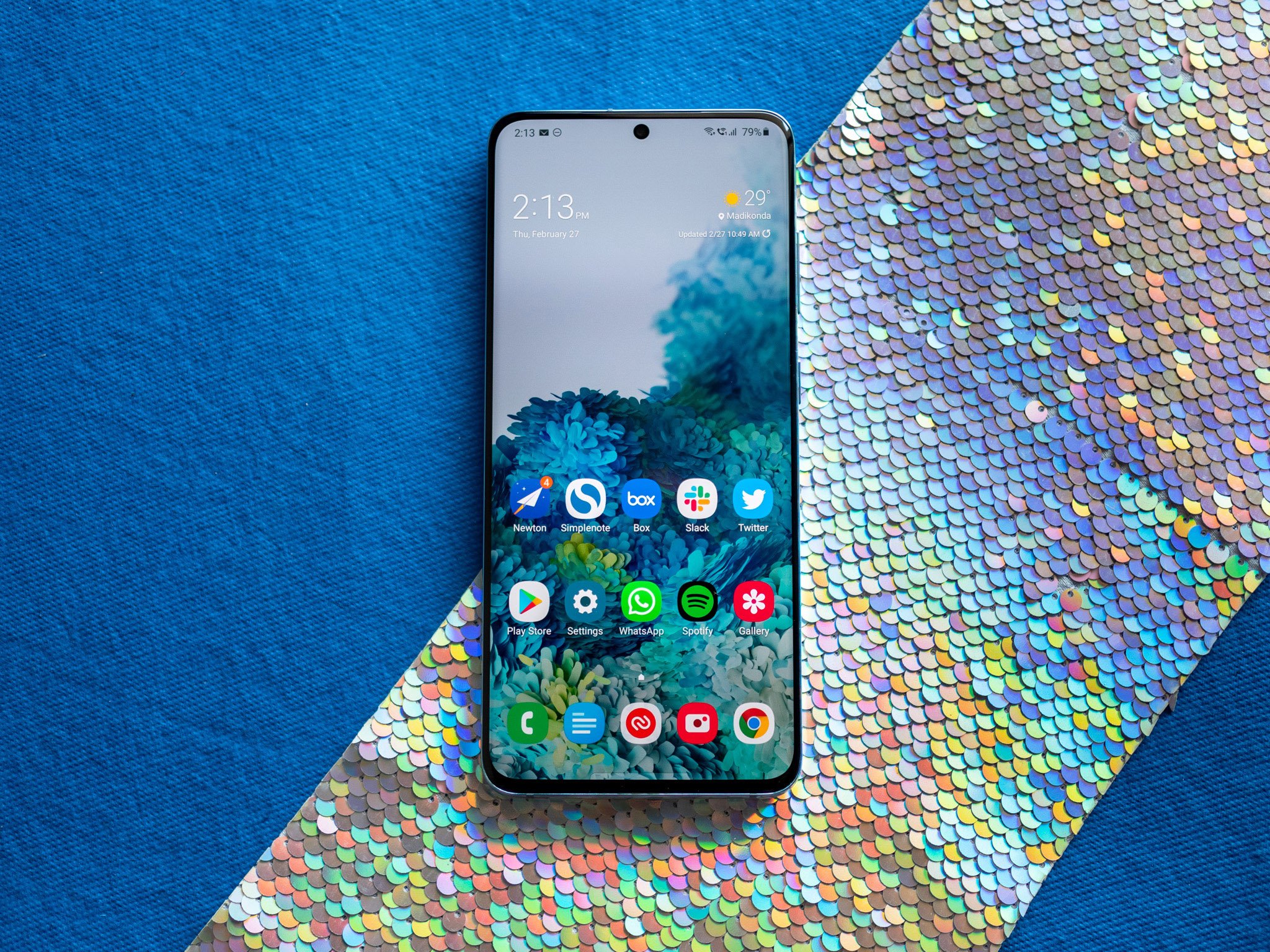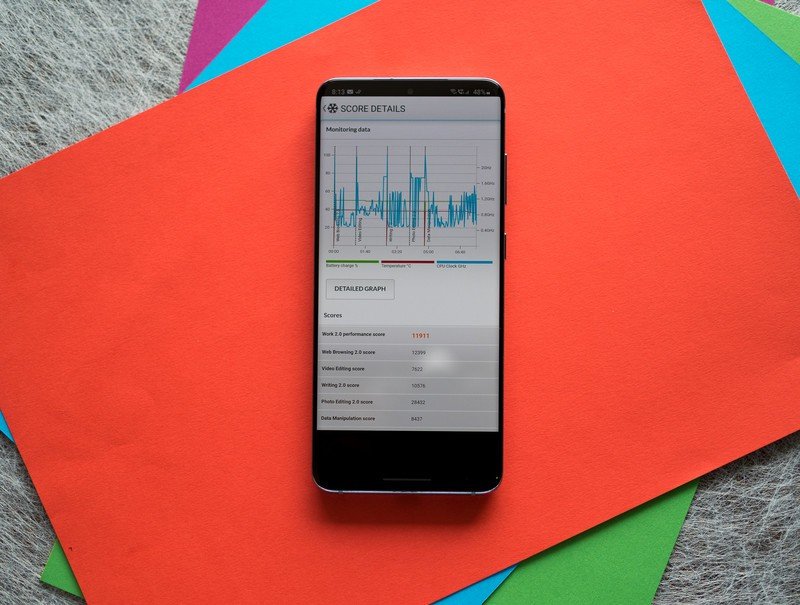Galaxy S20 Snapdragon 865 vs. Exynos 990 comparison: Performance, battery life, and more

Like previous generations, Samsung is offering two variants of the Galaxy S20. Samsung sells Snapdragon 865-powered phones in North America, and in most global markets the Galaxy S20 series is powered by Samsung's in-house Exynos 990 chipset. This isn't new — Samsung has been dual sourcing chipsets going as far back as the Galaxy Note 3, which debuted back in 2013.
With two distinct variants of the Galaxy S20 up for sale, it's time to find out if the Exynos 990-powered version of the S20 is on par with the Snapdragon version.
Snapdragon 865 vs. Exynos 990 design: 7nm nodes, external modems
While Samsung hasn't detailed why it uses both Qualcomm and its own Exynos designs in its phones, we can make a few guesses. Qualcomm has an effective monopoly on the CDMA standard, and for Samsung to offer its phones on Verizon, it needs to use a Snapdragon chipset. So why doesn't Samsung just use the Snapdragon 865 everywhere? The manufacturer stands to make more money in global markets by pushing its in-house solution instead of paying Qualcomm, so it uses Exynos chipsets in GSM-only markets.
Both chipsets are built on a 7nm node, and they both use external 5G modems for connectivity.
There are several differences between the two designs, but let's focus on the commonalities. Both the Exynos 990 and Snapdragon 865 are built on a 7nm node — the Exynos is manufactured at Samsung Foundry on a 7nm LPP process, and Qualcomm's design is manufactured at TSMC on an N7P process.
Samsung's extreme ultraviolet lithography (EUV) solution is the way forward for mobile chipsets as it leads to smaller, faster, and more energy-efficient designs, and TSMC's deep ultraviolet lithography (DUV) is a refinement of a proven formula.
Both designs also lack cellular connectivity, with Samsung pairing its chipset with the Exynos 5G Modem 5123 and Qualcomm using its Snapdragon X55 5G modem alongside the 865. As Samsung has more control over its in-house design, it is selling the Exynos 990 in both 4G-only and 5G configurations, with the former available in countries like India where there won't be any 5G connectivity for a few years.
In doing so, it is able to save costs and pass on those savings to customers. As a result, the Galaxy S20 series in India is more affordable than its U.S. counterpart, with the base model retailing at the equivalent of $905 (₹66,900). Samsung has a £100 differential between the 4G and 5G models of the Galaxy S20 in the UK, so if you're wondering, that's what the 5G modem is worth in a phone right now.
Be an expert in 5 minutes
Get the latest news from Android Central, your trusted companion in the world of Android
Snapdragon 865 vs. Exynos 990 benchmarks: Qualcomm still in the lead

Although Samsung made considerable gains in the mobile SoC segment with its Exynos chipsets, its designs aren't quite on par with what the best that Qualcomm has to offer. That was clearly the case in previous years, and things are unchanged in 2020 with the Galaxy S20 series.
Qualcomm has been in the lead for three years now, but Samsung gained a lot of ground with the Exynos 990.
Before we get started, let's take a look at what's on offer with each chipset. The Exynos 990 has a combination of three cores: there are two high-performance Mongoose M5 cores at 2.73GHz, along with two Cortex A76 cores at 2.50GHz, and four energy-efficient A55 cores at 2.0GHz. The Snapdragon 865, meanwhile, has newer cores: there's a single A77 core running at 2.84GHz, three A77 cores at 2.50GHz, with the four A55 cores at 1.80GHz.
On the GPU side of things, the Exynos 990 has the Mali-G77 MP11, with the MP11 indicating that 11 shader cores are active. The Snapdragon 865 has the Adreno 650, a refresh of last year's Adreno 640. Qualcomm has been the runaway leader in this area for the last three years, so it will be interesting to see if the Mali-G77 with its new Valhall architecture is able to hold its own against the Adreno 650.
I'm on the 4G-only variant of the Exynos 990 Galaxy S20 (SM-G980F/DS), and my North American colleagues are using the Snapdragon 865 versions: Ara Wagoner has the regular Galaxy S20, and Andrew Martonik is using the Galaxy S20 Ultra. I'm also adding the Realme X50 — a $500 value flagship — to the list as a baseline for the Snapdragon 865.
We ran the tests at 120Hz and 60Hz just to see if there was a noticeable difference between the two modes. As the 120Hz mode is limited to FHD, that's the resolution we used for 60Hz as well. Interestingly, we found that the S20 performed worse in 60Hz mode, suggesting Samsung is throttling the chipset to conserve power.
Performance
PCMark Work 2.0 (Higher is better)
| Device | Performance | Web Browsing | Video Editing | Writing | Photo Editing | Data Manipulation |
|---|---|---|---|---|---|---|
| Galaxy S20 Exynos 990 (120Hz) | 11987 | 12053 | 7676 | 11056 | 28017 | 8636 |
| Galaxy S20 Exynos 990 (60Hz) | 11945 | 12307 | 7614 | 10789 | 28255 | 8515 |
| Galaxy S20 SD865 (120Hz) | 11933 | 10626 | 7431 | 11566 | 26676 | 9939 |
| Galaxy S20 SD865 (60Hz) | 10265 | 8021 | 5921 | 11427 | 29609 | 7790 |
| Galaxy S20 Ultra SD865 (120Hz) | 12556 | 12090 | 7654 | 12449 | 27436 | 9877 |
| Galaxy S20 Ultra SD865 (60Hz) | 10677 | 8846 | 6142 | 12206 | 26423 | 7919 |
| Realme X50 SD865 (90Hz) | 13307 | 13803 | 6272 | 14649 | 37295 | 8823 |
PCMark Work 2.0 does a fantastic job emulating real-world usage conditions. Unlike other synthetic tests that are algorithm-based, PCMark focuses on real-world scenarios. Let's break down the numbers, kicking off with the web browsing test. This particular test is targeted at the A55 cores, and we see that the Exynos 990-based S20 has a marginal lead over the SD865 version. The fact that the A55 cores on the Exynos 990 go up to 2.0GHz contributes to the slight advantage here, with the SD865's A55 cores going up to 1.8GHz.
The video editing test uses OpenGL ES 2.0 and stresses factors like video playback. The scores are broadly identical across both variants of the S20, but it is interesting to see that the SD865 S20 fares worse in this test in 60Hz mode.
The writing test stresses the system's performance as it measures how long it takes to open, edit, and save a document. It is a great indicator to day-to-day performance, and the SD865 variants of the S20 pull ahead of the Exynos verison.
PCMark's photo editing test is particularly interesting because it measures how long it takes to open, edit, and save images. This test is designed to emulate how your phone performs when adding filters and beautify effects to your photos. Both chipsets perform at the same level, with the Exynos 990 eking out a lead over the SD865 versions of the S20. That said, the SD865 S20 in 60Hz mode posts the highest score of any of the S20 units.
Finally, the data manipulation test measures how long it takes to parse data from different file formats, and the frame rate while interacting with dynamic charts. The SD865 takes an immediate lead here over the Exynos 990, but once again we see that the scores in 60Hz mode are lower than 120Hz.
Overall, the Exynos 990 version of the Galaxy S20 fares very well, and it holds its own with the Snapdragon 865 in most scenarios. The key takeaway here is that Samsung seems to be throttling the chipset in 60Hz to deliver better battery life, as normally you would not see such a difference in scores from the same device.
Also, there is a noticeable variance between the Snapdragon variants of the S20 and Realme X50 even though both devices are using the same hardware. The Realme X50 is running at maximum frequency for the duration of the test — unlike the S20 — and that's what is causing the higher-than-usual scores.
CPU
Geekbench 5.0 (Higher is better)
| Device | Single core | Multi core |
|---|---|---|
| Galaxy S20 Exynos 990 (120Hz) | 914 | 2761 |
| Galaxy S20 Exynos 990 (60Hz) | 908 | 2737 |
| Galaxy S20 SD865 (120Hz) | 843 | 3087 |
| Galaxy S20 SD865 (60Hz) | 817 | 2878 |
| Galaxy S20 Ultra SD865 (120Hz) | 894 | 3206 |
| Galaxy S20 Ultra SD865 (60Hz) | 898 | 3188 |
| Realme X50 SD865 (90Hz) | 909 | 3349 |
Geekbench gives us a good overview of the performance from the CPU cores. Like last year, Samsung has the lead in the single-core scores, and that's down to the Mongoose M5 cores in the Exynos 990. However, when you look at the multi-core figures, Qualcomm is in the lead by a considerable margin. That's because it is using four Cortex A77 cores in total, and it is able to offer better sustained performance figures.
Graphics
GFXBench Aztec Ruins (Higher is better)
| Device | OpenGL (High) | OpenGL 1440p (High) | Vulkan 1440p (High) |
|---|---|---|---|
| Galaxy S20 Exynos 990 (120Hz) | 33 | 22 | 20 |
| Galaxy S20 Exynos 990 (60Hz) | 21 | 13 | 12 |
| Galaxy S20 SD865 (120Hz) | 29 | 21 | 20 |
| Galaxy S20 SD865 (60Hz) | 29 | 20 | 20 |
| Galaxy S20 Ultra SD865 (120Hz) | 29 | 20 | 20 |
| Galaxy S20 Ultra SD865 (60Hz) | 29 | 20 | 20 |
| Realme X50 SD865 (90Hz) | 29 | 20 | 20 |
The Exynos 990 version of the S30 posts the highest score overall, but it's interesting to see that there's a significant decline in the scores in 60Hz mode. There's no such issue on the SD865 versions.
3DMark Sling Shot Extreme (OpenGL ES3.1) (Higher is better)
| Device | Overall | Graphics | Physics |
|---|---|---|---|
| Galaxy S20 Exynos 990 (120Hz) | 6757 | 8393 | 4018 |
| Galaxy S20 Exynos 990 (60Hz) | 6673 | 8350 | 3919 |
| Galaxy S20 SD865 (120Hz) | 6666 | 7660 | 4586 |
| Galaxy S20 SD865 (60Hz) | 6403 | 8288 | 3756 |
| Galaxy S20 Ultra SD865 (120Hz) | 7108 | 8129 | 4938 |
| Galaxy S20 Ultra SD865 (60Hz) | 7079 | 8100 | 4913 |
| Realme X50 SD865 (90Hz) | 7198 | 8281 | 4938 |
3DMark Sling Shot Extreme (Vulkan) (Higher is better)
| Device | Overall | Graphics | Physics |
|---|---|---|---|
| Galaxy S20 Exynos 990 (120Hz) | 5000 | 6320 | 3170 |
| Galaxy S20 Exynos 990 (60Hz) | 5623 | 7287 | 3161 |
| Galaxy S20 SD865 (120Hz) | 6134 | 7731 | 3563 |
| Galaxy S20 SD865 (60Hz) | 5583 | 8130 | 2663 |
| Galaxy S20 Ultra SD865 (120Hz) | 6493 | 8030 | 3888 |
| Galaxy S20 Ultra SD865 (60Hz) | 6500 | 8087 | 3852 |
| Realme X50 SD865 (90Hz) | 6437 | 8129 | 3725 |
3DMark provides a decent overview of the graphical performance on offer, and here we see largely similar scores between both variants. The graphics test measures the performance of the GPU, with the physics test reliant more on the CPU. The Mali G77 posts very strong figures, and it's clear that ARM has reduced the deficit from previous years to Qualcomm in this area. The Vulkan test still sees the SD865 in the lead, but that could just be down to driver optimization.
Browser
Jetstream 2.0 (Higher is better)
| Device | Overall |
|---|---|
| Galaxy S20 Exynos 990 (120Hz) | 54.616 |
| Galaxy S20 Exynos 990 (60Hz) | 55.702 |
| Galaxy S20 SD865 (120Hz) | 62.516 |
| Galaxy S20 SD865 (60Hz) | 64.246 |
| Galaxy S20 Ultra SD865 (120Hz) | 71.927 |
| Galaxy S20 Ultra SD865 (60Hz) | 72.015 |
| Realme X50 SD865 (90Hz) | 65.252 |
Speedometer 2.0 (Higher is better)
| Device | Overall |
|---|---|
| Galaxy S20 Exynos 990 (120Hz) | 53.6 |
| Galaxy S20 Exynos 990 (60Hz) | 56.5 |
| Galaxy S20 SD865 (120Hz) | 58.7 |
| Galaxy S20 SD865 (60Hz) | 59.4 |
| Galaxy S20 Ultra SD865 (120Hz) | 65.5 |
| Galaxy S20 Ultra SD865 (60Hz) | 65.1 |
| Realme X50 SD865 (90Hz) | 69.4 |
Jetstream and Speedometer combine a series of JavaScript-based tests that measure the performance of browsers. Both tests crunch a lot of data and provide a single overall score, and that is usually indicative of how fast a browser renders the JavaScript tests. In this instance we see the SD865 versions of the S20 — particularly the S20 Ultra — easily pull into the lead.
Snapdragon 865 vs. Exynos 990 battery life: Better than last year
One of the biggest issues with Exynos designs in the past was battery life. Samsung's decision to chase higher frequencies meant that the Exynos versions of the Galaxy S9 and S10 had poor battery life figures when compared to their Snapdragon counterparts. The Exynos 9810-powered Galaxy S9 was so bad that Samsung had to issue a software update throttling the chipset to fix battery life issues. The Exynos 9820-powered S10 was similarly dogged by battery life woes last year.
With the Galaxy S20 series, Samsung seems to have made amends to an extent. I've used the Exynos 990-powered Galaxy S20 for just over two weeks, and I didn't have any issues with battery life. I regularly got screen-on-time of over five hours over the course of the day with 120Hz enabled throughout. That said, there are plenty of users over on Reddit that are seeing less-than-stellar battery figures from the Exynos-powered S20 series, so it looks like Samsung still has some work to do in this area.
Overall, the Snapdragon 865 version of the Galaxy S20 is once again the better option over the Exynos 990 variant, but not by a huge margin. Samsung fixed a lot of the underlying issues with Exynos-based designs in the past, and the Exynos 990 variant of the S20 is a great phone. It may not be quite on the same level as what Qualcomm is offering in terms of energy efficiency, but it is faring better than previous generations.

The flagship that has it all
The Galaxy S20 is packed with the latest hardware money can buy: there's a Snapdragon 865 chipset under the hood, 12GB of LPDDR5 RAM, UFS 3.0 storage, and exciting new camera modules. Combine that with all-day battery life and a stunning 120Hz AMOLED screen, and you get the best phone in the market today.

Harish Jonnalagadda is Android Central's Senior Editor overseeing mobile coverage. In his current role, he leads the site's coverage of Chinese phone brands, networking products, and AV gear. He has been testing phones for over a decade, and has extensive experience in mobile hardware and the global semiconductor industry. Contact him on Twitter at @chunkynerd.
